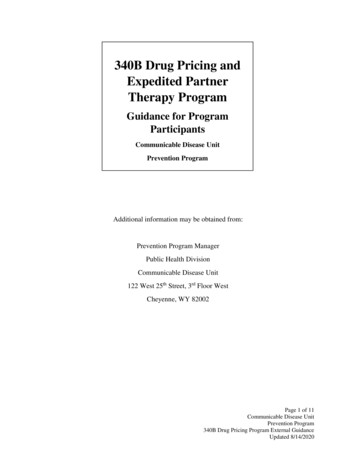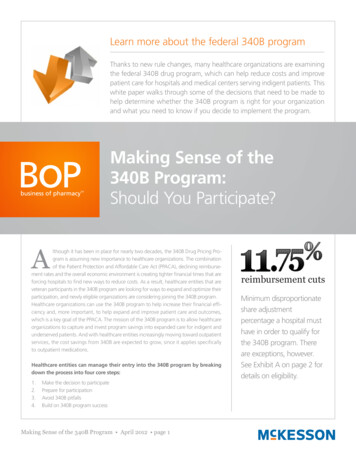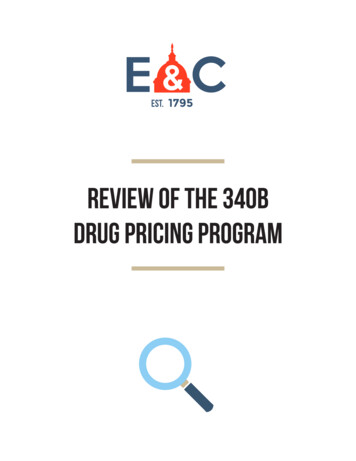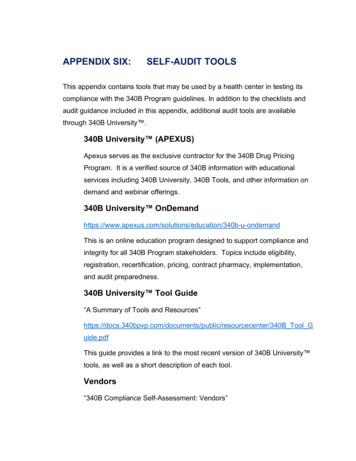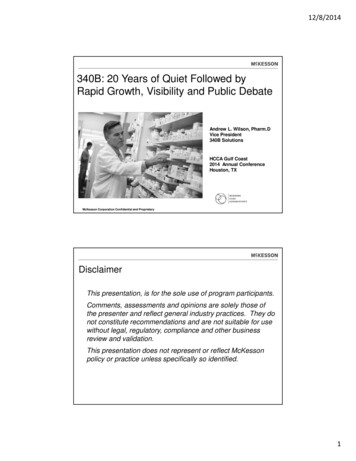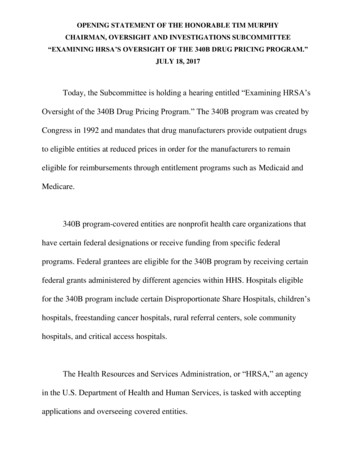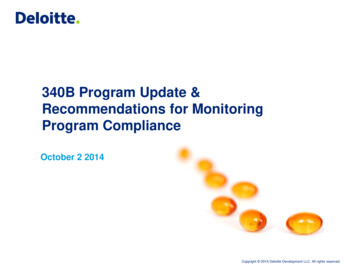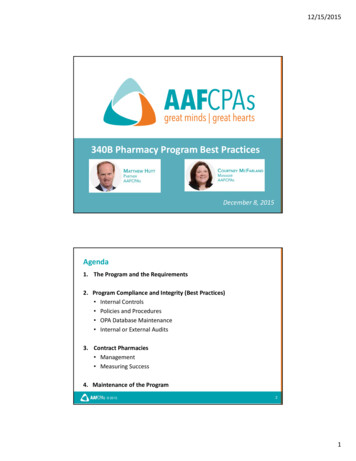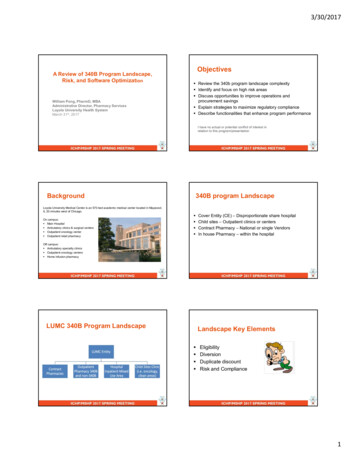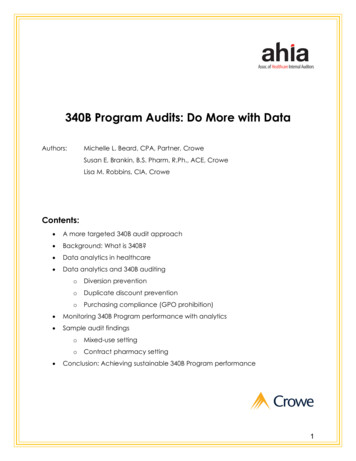
Transcription
340B Program Audits: Do More with DataAuthors:Michelle L. Beard, CPA, Partner, CroweSusan E. Brankin, B.S. Pharm, R.Ph., ACE, CroweLisa M. Robbins, CIA, CroweContents: A more targeted 340B audit approach Background: What is 340B? Data analytics in healthcare Data analytics and 340B auditingoDiversion preventionoDuplicate discount preventionoPurchasing compliance (GPO prohibition) Monitoring 340B Program performance with analytics Sample audit findings oMixed-use settingoContract pharmacy settingConclusion: Achieving sustainable 340B Program performance1
A more targeted 340B audit approachThe 340B Drug Pricing Program has faced increased scrutiny by the U.S.Health Resources and Services Administration (HRSA) over the years aswell as public challenges by drug manufacturers to limit or change the340B Drug Pricing Program’s contract pharmacy operations, point-ofpurchase 340B discounts, and “good faith” inquiries in recent months. Thisenvironment makes having insight into risk areas associated with theprogram even more crucial for today’s healthcare internal auditors. Usingdata analytics (DA) to address compliance concerns can help auditorsenhance insights and execute a more efficient, targeted audit approachto a covered entity’s 340B Program.This article provides background on the 340B Program, a review of dataanalytics and its abilities, and strategies for use in key risk areas, includingdiversion, duplicate discounts, and purchasing practices. It also includessample audit findings to illustrate data analytics’ capabilities inilluminating 340B compliance issues.Background: What is 340B?Created by the U.S. federal government in 1992, the 340B Programrequires drug manufacturers that participate in Medicaid to provideoutpatient drugs to eligible healthcare organizations and coveredentities at significantly reduced prices. The program is intended to helpcovered entities stretch scarce federal resources, allowing them to reach more eligiblepatients and provide more comprehensive healthcare services.HRSA’s Office of Pharmacy Affairs (OPA) administers the 340B Program and interpretsand implements 340B Program statutes. HRSA is responsible for issuing guidance relatedto the 340B Program and has the authority to audit covered entities to assesscompliance with program requirements. In 2017, HRSA contracted with the BizzellGroup, which now performs the audits on HRSA’s behalf. The Bizzell Group hires2
pharmacists and experienced experts in the 340B Program to conduct audits, whichhas improved the quality and depth of HRSA audits.Currently, six types of hospitals are eligible to participate in the 340B Program: Children’s hospitals (PED) Critical access hospitals (CAH) Disproportionate share hospitals (DSH) Freestanding cancer hospitals (CAN) Rural referral centers (RRC) Sole community hospitals (SCH)In addition, these nonhospital covered entities are eligible for the 340B Program: Federally qualified health centers (FQHCs) FQHC look-alikes (community-based healthcare providers that meet therequirements of the HRSA Health Center Program but do not receive programfunding) Native Hawaiian health centers Tribal and urban Indian health centers Ryan White HIV/AIDS Program grantees Black lung clinics Comprehensive hemophilia diagnostic treatment centers Title X family planning clinics Sexually transmitted disease clinics Tuberculosis clinicsTo participate in the 340B Program, covered entities must register with HRSA andcomply with all program requirements,1 which include: Meeting eligibility requirements and recertifying every year3
Keeping OPA Information System (340B OPAIS) information up to date andaccurate Preventing duplicate discounts Preventing drug diversion to ineligible patients Preparing for program audits, including maintaining auditable recordsdocumenting compliance with 340B Program requirementsData analytics in healthcareData analytics (DA) is the process of analyzing large data sets to drawinsights into and conclusions about the information within the data sets.DA is aided by software and emerging technologies that analyze thedata sets to produce meaningful takeaways.The healthcare industry has become increasingly data reliant as a result of the wideadoption and use of electronic medical records (EMRs), patient financial reporting, andinventory management systems across all sectors. Data analytics technologies enablehealthcare organizations to make more informed decisions in areas such as clinicaleffectiveness, compliance, performance improvement, and finance.Healthcare internal audit and compliance departments rely on data analytics toimprove auditing, monitoring, and compliance, which provides auditors with anenhanced understanding of risks and opportunities. Use of data analytics is particularlyvaluable in the healthcare field, given its complex regulatory and reporting landscape.Data analytics and 340B auditingOne of data analytics’ greatest benefits for 340B Program internal auditors is its ability toassist auditors in testing 100% of the entity’s qualified dispensations and program data.Having complete insight into program data – versus relying on small sample size audits –can aid auditors in uncovering problem areas more quickly while providing additionalcomfort in overall program compliance.4
First, auditors must understand a covered entity’s 340B definitions and eligibility criteriawhen using data analytics. This knowledge can allow them to test 100% of drugadministrations in the mixed-use setting (a hospital area serving both outpatients andinpatients) and prescriptions in the owned retail (retail pharmacy owned by thecovered entity) or contract pharmacy (an outside pharmacy with which the coveredentity contracts to provide pharmacy services using medications purchased throughthe 340B Program) setting with meaningful results.Additionally, it is critical to understand a covered entity’s specific patient definitionwhen testing for compliance issues, as patient definitions vary widely from coveredentity to covered entity. For example, the eligible patient definition should include howeligible transactions are qualified (at the time of drug dispensing, drug administration, ordrug billing) and whether eligibility is determined in real time or is batched.Typically, to aid in 340B compliance, 340B Program covered entities use softwaresolutions for patient eligibility identification, inventory management, dispensing andreplenishment, and reporting. These software solutions commonly are referred to as“split-billing software” because they split replenishment orders for eligible medicationsinto various purchasing accounts based on the covered entity’s eligible patientdefinition criteria. Software solutions might use a covered entity’s charge data,administration data, or a combination of both to determine eligible 340B transactions.Last, internal auditors need to determine the source of truth for eligibility data whenusing data analytics. Doing so helps auditors confirm they are comparing theappropriate data elements representing the covered entity’s patient definition used byHRSA auditors. Auditors also need to confirm which systems supply the data used todetermine eligibility (for example, patient financial system, EMR, pharmacy system,physician credentialing, or pharmacy wholesaler inventory management system).Following is a closer look at how healthcare internal auditors can use DA to take a moretargeted audit approach in the top 340B Program risk areas of diversion, duplicate5
discount, and purchasing compliance.Diversion preventionPer Section 340B(a)(5)(B) of the Public Health Service Act, covered entities areprohibited from reselling or otherwise transferring a drug to a person who is not apatient of the entity.2 Diversion occurs when a 340B drug is: Provided to an individual who is not an eligible outpatient of the entity Dispensed either through administration or prescription in an area of a facility orlocation that is not eligible Administered or prescribed to a patient who receives healthcare services from ahealthcare professional who neither is employed by the covered entity norprovides healthcare under contractual or other arrangements or is notsupported by documentation in the medical record as being provided to aneligible patientAuditors can use diversion prevention analytics to confirm the provider writing theprescription or administering the medication is an eligible provider as defined by thecovered entity, that the location where the medication is ordered or administered is aneligible location, and that the patient encounter is eligible as defined by HRSA’s 340BProgram guidance. By reviewing these key data elements, auditors can uncoverpotential diversion issues prior to the medication being purchased on 340B.Examples of ways in which healthcare internal auditors could use DA in the area of drugdiversion prevention include: Mixed-use setting: Match 340B accumulation data by National Drug Code(NDC) to drug administration data. By comparing drug administration data fromthe EMR to 340B accumulation data from the split-billing software, auditors mightdiscover drugs that are billed on dispense and accumulated as 340B but nevercharted as administered, which is key to eligibility testing for HRSA.6
Owned retail or contract pharmacy services: Match 340B and prescription datato the covered entity’s defined eligible provider list and eligible location list. Clean-use service (hospital offsite clinic, department, or service that serves onlyoutpatients): Match purchasing records and expired medication documentationto drug administration and waste capture data from the EMR to confirm allmedications purchased through the 340B Program were administered, wasted,or expired.Duplicate discount preventionDrug manufacturers are not required to provide a discounted 340B priceto a covered entity and a Medicaid drug rebate to the state for thesame drug. This stipulation is known as a “duplicate discount.” As part ofthe 340B Program, covered entities must have mechanisms in place toprevent duplicate discounts.Covered entities in the 340B Program need to decide whether they will dispense 340Bpurchased drugs to their Medicaid fee-for-service (FFS) patients – known as “carving in”– or if they will not use 340B purchases for their Medicaid FFS patients, which is known as“carving out.” In the contract pharmacy setting, covered entities are required to carveout unless they are contracted with the state to do otherwise.If covered entities decide to bill Medicaid FFS for drugs purchased under the 340BProgram using a Medicaid provider number or National Provider Identifier (NPI), then alldrugs billed under that number must be purchased through the 340B Program. TheMedicaid provider number or NPI must be listed in the Medicaid Exclusion File (MEF)maintained by HRSA.Covered entities participating in the 340B Program also must comply with all stateMedicaid laws that mandate billing requirements for 340B purchased medications. Thismight include billing the drug ingredient cost or adding claim modifiers. States alsomight determine whether the Medicaid billing requirement includes 340B purchasedmedications billed to Medicaid managed care organizations (MCOs). Covered entities7
billing out-of-state Medicaid agencies for 340B purchased medications must complywith each state’s billing requirements.Examples of ways in which healthcare internal auditors could use DA in the area ofduplicate discount prevention include: For 340B Medicaid carve-in mixed-use and owned retail:oBased on state-specific FFS Medicaid outpatient billing requirements(MCO included if required by state), internal auditors can reviewMedicaid outpatient claims data files (837 claims) to assess whether therequired billing claim modifier is appended to all unbundled hospitaladministered drugs and entity-owned retail pharmacy prescriptions andthat the required drug ingredient cost is charged. For 340B Medicaid carve-out mixed-use and owned retail:oBased on state-specific FFS Medicaid outpatient billing requirements(MCO included if required by state), auditors can review Medicaidoutpatient claims for a Medicaid payer. For 340B Medicaid carve-out contract pharmacy:oAuditors can review contract pharmacy payer data for a Medicaid FFSpayer (MCO included if required by state) by bank identification number(BIN), processor control number (PCN), or group ID. If a BIN, PCN, or groupID is not provided, auditors can test against a hospital payer field toconfirm no Medicaid payer exists for the claim.Purchasing compliance (GPO prohibition)Per 340B Program rules, DSHs, PEDs, and CANs participating in the 340BProgram cannot obtain covered outpatient drugs through a grouppurchasing organization (GPO) or other group purchasing arrangement.If a covered entity violates GPO prohibition, it would be consideredineligible for the 340B Program for the time period in which it violated the rule. Thisineligibility can result in significant financial loss to the covered entity or removal fromthe 340B Program.8
A covered entity can define certain drugs as exclusions to the covered outpatient drugdefinition. These drugs cannot be purchased through the 340B Program, but they alsoare not subject to 340B Program requirements such as GPO prohibition and maytherefore be purchased on a GPO account. A covered entity’s interpretation ofexclusions to the covered outpatient drug definition should be defensible, consistentlyapplied in all areas, noted in all 340B Program policies and procedures, and auditable.An example of a way in which healthcare internal auditors could use DA in the area ofGPO prohibition compliance includes: Identifying inappropriate GPO purchasing by comparing GPO accumulations byNDC to GPO purchases by NDCMonitoring 340B Program performance with analyticsContinual monitoring of overall 340B Program performance is essentialfor covered entities to maximize savings and uphold the highest level ofprogram compliance. By using analytics, auditors can better identifydata transfer issues and purchasing practices to identify compliancerisks that can weaken program performance and opportunities for additional programsavings.Examples of how internal auditors can use analytics to monitor 340B Programperformance include: Reviewing gaps in service dates, volume-by-service date, and duplicate records,which can identify unusual variations in quantity of records and detect datatransfer issues Performing data analytics to maximize financial savings including assessing thecovered entity’s contract pharmacy program to achieve revenue maximization9
Sample audit findingsExamples of audit findings resulting from data analytics testing in the mixed-use andcontract pharmacy setting are listed here to aid in identifying risk areas within a 340BProgram.Mixed-use setting Inaccurate inpatient versus outpatient accumulation data:oHospital programming logic incorrectly identified outpatient versusinpatient transactions.oInitial patient status was being entered incorrectly, with the correctedstatus not being communicated to the 340B vendor software. Medicaid carve-out billing errors:oMedicaid FFS (or MCO if required by state) was a secondary or tertiarypayer and billed for 340B medications.oOut-of-state Medicaid MCO was billed for 340B medications, and statebilling requirements were not followed. Medicaid carve-in billing errors:oAll Medicaid billing numbers, including NPIs, the covered entity used werenot registered on the OPAIS.oOut-of-state Medicaid billing numbers were not registered on the OPAIS.oBilling modifiers were not included on the claims data for FFS (or MCO ifrequired by state) for out-of-state Medicaid claims. Duplicate accumulations:o Data upload omissions or failures:o Manual uploads for the same transactions occurred more than once.Uploads to 340B vendor software had missing, partial, or duplicate data.Drug reversal and credits not interfacing correctly to the accumulator:oData sent to 340B vendor software was based on service date rather thanpostdate.oNegative quantities were not being sent to 340B vendor software.10
Medication purchased outside the pharmacy not included in 340B data:oData for medication dispensed outside the pharmacy was not being sentto the 340B software vendor for proper accumulation and purchases.Contract pharmacy setting Prescriptions filled for animals:o Prescription qualified on provider eligibility only.Eligible patient encounters from child site locations not considered: The eligible location list sent by the covered entity to the 340B softwarevendor was not updated or included in software logic to determineeligibility. Ineligible patient encounter deemed 340B eligible:oThe 340B software solution used incorrect logic to match to patientencounters.oIneligible locations were being sent as eligible to the 340B softwarevendor.oThe 340B software vendor was not using both location and provider todetermine eligibility. Prescribing physician with no contractual relationship to the covered entity:oProvider list used by 340B software vendor was inaccurate or not updatedby the covered entity.oThe 340B software vendor was using incorrect logic to match providers(contractual versus employed). Duplicate prescriptions:o Duplicate data files were sent to the 340B software vendor.Medicaid patients not carved out:oMedicaid BINs, PCNs, and group IDs were not correctly identified andexcluded by 340B software vendor.oMedicaid MCO (where required by state) was not included in theMedicaid payer exclusion list.11
Conclusion: Achieving sustainable 340B Program performanceAs the 340B Program faces increased federal scrutiny and challenges from drugmanufacturers, it’s more important than ever for internal auditors to have thoroughinsights into a covered entity’s 340B Program. Data analytics can help internal auditorsachieve a more effective audit, identifying risk areas and helping the covered entitycomply with program rules. In addition, by being able to test 100% of certain 340Brequirements, covered entities can be better positioned to show the strength of theirprograms to HRSA and drug manufacturers.By using data analytics, internal auditors are better able to continually monitor 340BPrograms. Monitoring assists covered entities in achieving sustainable performance and,ultimately, frees up valuable time for covered entities to focus on goals such asprogram expansion that can allow for increased patient access to much-neededmedications and healthcare services.Endnotes:1 “ProgramRequirements,” U.S. Health Resources and Services quirements/index.html2 Sec.340B Public Health Service Act, “Limitation on Prices of Drugs Purchased by Covered Entities,” U.S.Health Resources and Services f12
About AHIAThe Association of Healthcare Internal Auditors (AHIA) is a network of experiencedhealthcare internal auditing professionals who come together to share tools,knowledge, and insight on how to assess and evaluate risk within a complex anddynamic healthcare environment. AHIA is an advocate for the profession,continuing to elevate and champion the strategic importance of healthcareinternal auditors with executive management and the Board. If you have a stake inhealthcare governance, risk management and internal controls, AHIA is your onestop resource. Explore our website for more information. If you are not a member,please join our network, www.ahia.org. AHIA white papers provide healthcareinternal audit practitioners with non-mandatory professional guidance on importanttopics. By providing healthcare specific information and education, white paperscan help practitioners evaluate risks, develop priorities, and design auditapproaches. It is meant to help readers understand an issue, solve a problem, ordecide. AHIA welcomes papers aimed at beginner to expert level practitioners. Thisincludes original content clearly related to healthcare internal auditing that doesnot promote commercial products or services.Interested? Contact a member of the AHIA White Paper Subcommittee.SubcommitteeAlan Henton, White Paper Chairalan.p.henton@vumc.orgMark Eddymark.eddy@hcahealthcare.comLinda Greertlbmc@cox.netDebi Weatherforddebi.weatherford@piedmont.orgLaura L. lth.comDeborah Pazourek, AHIA Board LiaisonDeborah.L.Pazourek@medstar.net13
Typically, to aid in 340B compliance, 340B Program covered entities use software solutions for patient eligibility identification, inventory management, dispensing and replenishment, and reporting. These software solutions commonly are referred to as "split-billing software" because they split replenishment orders for eligible medications
